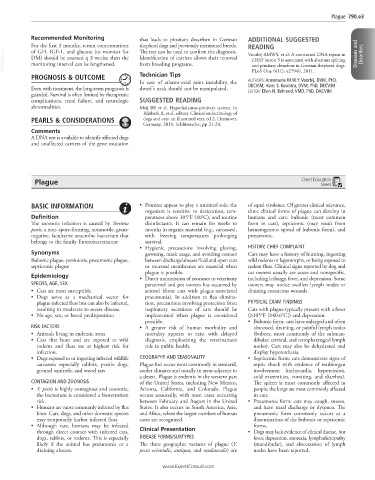Page 1572 - Cote clinical veterinary advisor dogs and cats 4th
P. 1572
Plague 790.e3
Recommended Monitoring that leads to pituitary dwarfism in German ADDITIONAL SUGGESTED
For the first 3 months, serum concentrations shepherd dogs and previously mentioned breeds. READING
VetBooks.ir DM) should be assessed q 3 weeks; then the Identification of carriers allows their removal Voorbij AMWY, et al: A contracted DNA repeat in Diseases and Disorders
The test can be used to confirm the diagnosis.
of GH, IGF-1, and glucose (to monitor for
LHX3 intron 5 is associated with aberrant splicing
monitoring interval can be lengthened.
from breeding programs.
and pituitary dwarfism in German shepherd dogs.
PROGNOSIS & OUTCOME Technician Tips PLoS One 6(11): e27940, 2011.
In case of atlanto-axial joint instability, the AUTHORS: Annemarie M.W.Y. Voorbij, DVM, PhD,
Even with treatment, the long-term prognosis is dwarf’s neck should not be manipulated. DECVIM; Hans S. Kooistra, DVM, PhD, DECVIM
EDITOR: Ellen N. Behrend, VMD, PhD, DACVIM
guarded. Survival is often limited by therapeutic
complications, renal failure, and neurologic SUGGESTED READING
abnormalities. Meij BP, et al: Hypothalamus-pituitary system. In
Rijnberk A, et al, editors: Clinical endocrinology of
PEARLS & CONSIDERATIONS dogs and cats: an illustrated text, ed 2, Hannover,
Germany, 2010, Schlütersche, pp 21-24.
Comments
A DNA test is available to identify affected dogs
and unaffected carriers of the gene mutation
Plague Client Education
Sheet
BASIC INFORMATION • Fomites appear to play a minimal role; the of equal virulence. Of greater clinical relevance,
organism is sensitive to desiccation, tem- three clinical forms of plague can develop in
Definition peratures above 105°F (40°C), and routine humans and cats: bubonic (most common
The zoonotic infection is caused by Yersinia disinfectants. It can remain for weeks to form in cats), septicemic (may result from
pestis, a non–spore-forming, nonmotile, gram- months in organic material (e.g., carcasses), hematogenous spread of bubonic form), and
negative, facultative anaerobic bacterium that with freezing temperatures prolonging pneumonic.
belongs to the family Enterobacteriaceae survival.
• Hygienic precautions involving gloving, HISTORY, CHIEF COMPLAINT
Synonyms gowning, mask usage, and avoiding contact Cats may have a history of hunting, ingesting
Bubonic plague, yersiniosis, pneumonic plague, between discharge/abscess fluid and open cuts wild rodents or lagomorphs, or being exposed to
septicemic plague or mucosal membranes are essential when rodent fleas. Clinical signs reported by dog and
plague is possible. cat owners usually are acute and nonspecific,
Epidemiology • Direct transmission of zoonoses to veterinary including lethargy, fever, and depression. Some
SPECIES, AGE, SEX personnel and pet owners has occurred by owners may notice swollen lymph nodes or
• Cats are most susceptible. aerosol (from cats with plague-associated draining cutaneous wounds.
• Dogs serve as a mechanical vector for pneumonia). In addition to flea elimina-
plague-infected fleas but can also be infected, tion, precautions involving protection from PHYSICAL EXAM FINDINGS
resulting in moderate to severe disease. respiratory secretions of cats should be Cats with plague typically present with a fever
• No age, sex, or breed predisposition implemented when plague is considered (≥105°F [≥40.6°C]) and depression.
possible. • Bubonic form: cats have enlarged and often
RISK FACTORS • A greater risk of human morbidity and abscessed, draining, or painful lymph nodes
• Animals living in endemic areas mortality appears to exist with delayed (buboes, most commonly of the subman-
• Cats that hunt and are exposed to wild diagnosis, emphasizing the veterinarian’s dibular, cervical, and retropharyngeal lymph
rodents and fleas are at highest risk for role in public health. nodes). Cats may also be dehydrated and
infection. display hyperesthesia.
• Dogs exposed to or ingesting infected wildlife GEOGRAPHY AND SEASONALITY • Septicemic form: cats demonstrate signs of
carcasses; especially rabbits, prairie dogs, Plague foci occur most commonly in semiarid, septic shock with evidence of multiorgan
ground squirrels, and wood rats cooler climates and usually in areas adjacent to involvement (tachycardia, hypotension,
a desert. Plague is endemic in the western part cold extremities, vomiting, and diarrhea).
CONTAGION AND ZOONOSIS of the United States, including New Mexico, The spleen is most commonly affected in
• Y. pestis is highly contagious and zoonotic; Arizona, California, and Colorado. Plague people; the lungs are most commonly affected
the bacterium is considered a bioterrorism occurs seasonally, with most cases occurring in cats.
risk. between February and August in the United • Pneumonic form: cats may cough, sneeze,
• Humans are most commonly infected by flea States. It also occurs in South America, Asia, and have nasal discharge or dyspnea. The
bites. Cats, dogs, and other domestic species and Africa, where the largest numbers of human pneumonic form commonly occurs as a
may temporarily harbor infected fleas. cases are recognized. dissemination of the bubonic or septicemic
• Although rare, humans may be infected Clinical Presentation forms.
through direct contact with infected cats, • Dogs may lack evidence of clinical disease, but
dogs, rabbits, or rodents. This is especially DISEASE FORMS/SUBTYPES fever, depression, anorexia, lymphadenopathy
likely if the animal has pneumonia or a The three geographic variants of plague (Y. (mandibular), and abscessation of lymph
draining abscess. pestis orientalis, antiqua, and mediaevalis) are nodes have been reported.
www.ExpertConsult.com

